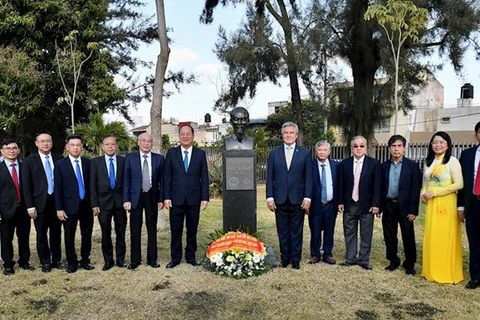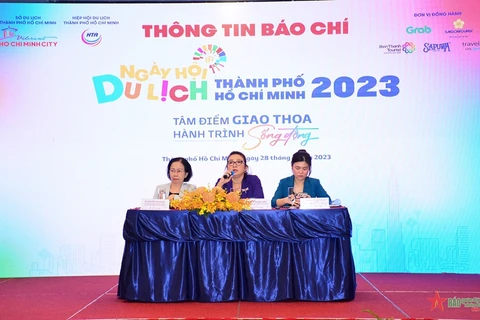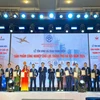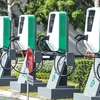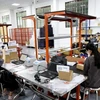HCM City (VNS/VNA) - Four international exhibitions, Paper Vietnam, Rubber and Tyre Vietnam, Coatings Expo Vietnam, and Plastech Vietnam, will be held in Ho Chi Minh City from June 14 to 16.
The expos are expected to attract 230 companies, 50% higher than that of last year’s shows, said Nguyen Ba Vinh, Director of Minh Vi Exhibition and Advertisement Services Co Ltd, the expos’ organiser.
They are from 20 countries and territories, and India continues to be the country of honour at the expos, with many Indian companies taking part, he said.
Speaking at a press briefing on March 28 to introduce the four expos, Luu Hoang Ngoc, Deputy General Director of Vietnam Chemicals Agency under the Ministry of Industry and Trade, said paint, paper, rubber and plastic industries played an important role in supporting the development of many other industries.
Rapid development of a rich and diverse range of products in recent years also raised concerns about their harmful effects on the environment and human health. This required authorities, organisations and businesses to join hands to find solutions for this issue, he said.
"Green economy, circular economy and sustainable development are inescapable global trends, and businesses need to embrace them to enhance their competitiveness despite facing challenges," he added.
Nguyen Thi Lac Huyen, Chairwoman of the Vietnam Paint and Printing Ink Association, said the coating and printing ink industry recorded negative growth last year, with output of certain types of paints plunging between up to 40-50% due to low demand in the domestic and export markets.
The printing ink industry also witnessed a decrease of around 10% in output last year, she said.
This year would continue to be a difficult year for the paint and printing ink industry due to high prices of raw materials and a decline in demand, she said.
The expos would help firms update market information and technology, and find partners to boost the paint and printing ink industry’s recovery, Huyen said.
She also said that many businesses had conducted research to make more environmentally-friendly paint products to meet market requirements.
In the plastic industry, companies had invested in giving new life to used plastic products, while the rubber industry had a high recycling rate with all used types recycled, said Nguyen Quoc Anh, Chairman of the HCM City Rubber-Plastic Manufacturers Association.
By focusing on environmentally friendly and sustainable practices, companies could gain a competitive advantage in the market, he added./.
The expos are expected to attract 230 companies, 50% higher than that of last year’s shows, said Nguyen Ba Vinh, Director of Minh Vi Exhibition and Advertisement Services Co Ltd, the expos’ organiser.
They are from 20 countries and territories, and India continues to be the country of honour at the expos, with many Indian companies taking part, he said.
Speaking at a press briefing on March 28 to introduce the four expos, Luu Hoang Ngoc, Deputy General Director of Vietnam Chemicals Agency under the Ministry of Industry and Trade, said paint, paper, rubber and plastic industries played an important role in supporting the development of many other industries.
Rapid development of a rich and diverse range of products in recent years also raised concerns about their harmful effects on the environment and human health. This required authorities, organisations and businesses to join hands to find solutions for this issue, he said.
"Green economy, circular economy and sustainable development are inescapable global trends, and businesses need to embrace them to enhance their competitiveness despite facing challenges," he added.
Nguyen Thi Lac Huyen, Chairwoman of the Vietnam Paint and Printing Ink Association, said the coating and printing ink industry recorded negative growth last year, with output of certain types of paints plunging between up to 40-50% due to low demand in the domestic and export markets.
The printing ink industry also witnessed a decrease of around 10% in output last year, she said.
This year would continue to be a difficult year for the paint and printing ink industry due to high prices of raw materials and a decline in demand, she said.
The expos would help firms update market information and technology, and find partners to boost the paint and printing ink industry’s recovery, Huyen said.
She also said that many businesses had conducted research to make more environmentally-friendly paint products to meet market requirements.
In the plastic industry, companies had invested in giving new life to used plastic products, while the rubber industry had a high recycling rate with all used types recycled, said Nguyen Quoc Anh, Chairman of the HCM City Rubber-Plastic Manufacturers Association.
By focusing on environmentally friendly and sustainable practices, companies could gain a competitive advantage in the market, he added./.


